DOE charts show why climate doom and gloom isn't needed
Posted on 4 October 2016 by dana1981
A new report from the US Department of Energy paints a bright picture for our prospects to cut carbon pollution and prevent the most dangerous levels of climate change. The report looked at recent changes in costs and deployment of five key clean energy technologies: wind, residential solar, utility-scale solar, batteries, and LED bulbs. For each technology, costs fell between 41% and 94% from 2008 to 2015.
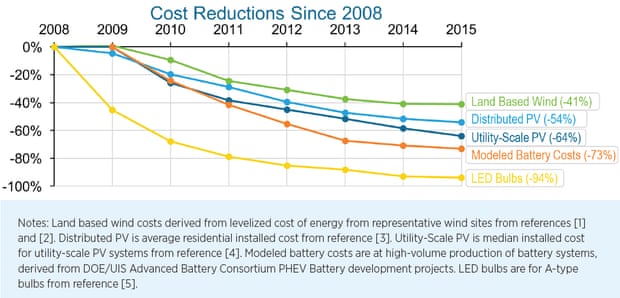
Cost reductions in five key clean technologies since 2008. Illustration: US Department of Energy
Good news for doom and gloom environmentalists
Many who understand the realities and dangers of human-caused global warming are afraid that we’ll fail to avoid catastrophic climate change. Among this group, even positive climate stories are often viewed through a lens of pessimism, and we often see stories about the likelihood that we’ll miss climate targets.
However, it’s important to acknowledge the progress that’s being made, and retain a sense of hope and optimism that we can still avoid the worst climate consequences. This new DOE report highlights the fact that clean energy technology is quickly moving in the right direction, toward lower costs and higher deployment.
Wind energy is blowing away expectations
The report finds that due to its low cost, US wind energy capacity has nearly tripled since 2008. Wind now supplies nearly 5% of total US electricity generation.
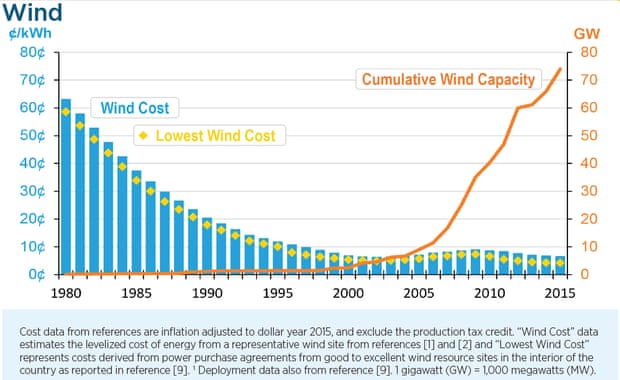
Wind cost and cumulative installed capacity in the USA. Illustration: US Department of Energy
As a result, there are now nearly 90,000 U.S. manufacturing, construction, and wind operations jobs. Research has resulted in bigger turbines that can generate more electricity:
a wind turbine installed today on average has 108% longer blades and is 48%taller than one installed in 1999. The longer blades allow each turbine to capture more energy, and taller towers allow access to the stronger and more consistent wind speeds that occur at higher altitudes in many parts of thecountry. Combined, these innovations allow each turbine to produce more electricity, reducing both the number of turbines needed to produce a given amount of electricity and the land area needed for their installation.
Offshore wind also presents tremendous untapped potential, with the first such project set to begin generating power off the cost of Rhode Island this month. The DOE envisions wind generating 20% of the nation’s electricity by 2030 and 35% by 2050, with costs falling a further 35% by 2050.
Solar energy’s bright future
Utility-scale solar farm costs have fallen 64% since 2008, and distributed (mostly residential) solar costs by 54%. While solar still accounts for a relatively small percentage of overall US electricity generation, its deployment has been increasing rapidly as costs have dropped. Even the military is getting on board:
For example in 2015 the Department of the Navy procured 210 MW of a utility-scale PV project to support fourteen Navy installations in California.
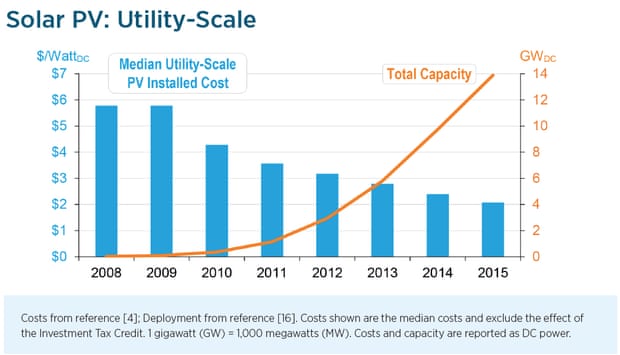
In 2015, the solar sector employed about 220,000 Americans. The DOE envisions that solar power could supply 27% of US electricity generation by 2050. Solar deployment is surging in 2016, with around 10 gigawatts (GW) set to be installed this year – equal to all the solar capacity installed in the US through 2014.
Solar panel leasing from companies like Solar City and Sungevity has revolutionized the distributed solar market, accounting for the majority of domestic residential system installed in leading state markets in 2015. This approach makes solar panels obtainable for households that can’t afford to purchase them. Distributed solar costs are expected to fall a further 16–33% by 2020.
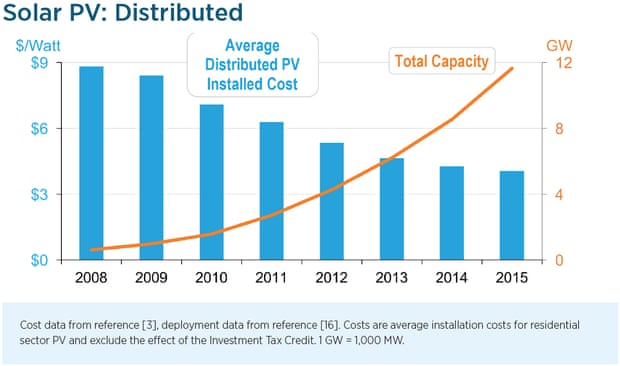
Distributed solar cost and cumulative installed capacity in the USA. Illustration: US Department of Energy
Stunning drop in LED costs
The best available LED bulbs use 85% less energy than incandescent bulbs. Although their high efficiency slashes electric bills, the bulbs’ high cost was initially a deterrent to many consumers. However, LED costs have plummeted 94% since 2008. From 2014 to 2015, LED installations in the US more than doubled, and already account for 6% of installed A-type lightbulbs, as well as 11% and 21% of directional bulbs and outdoor lighting fixtures, respectively.
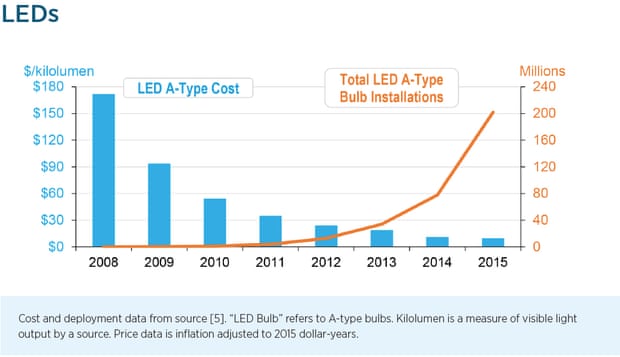
LED cost and installations in the USA. Illustration: US Department of Energy
By 2035, DOE anticipates that LEDs will account for 85% of American’s lighting installations, saving Americans nearly $630 billion in avoided energy costs.
Electric cars are the future of transportation
Electric vehicle (EV) sales in the US reached 115,000 in 2015, more than double the number sold in 2012. Overall US EV sales will surpass a half-million by the end of this year. As shown by a new paper and app from MIT, EVs reduce greenhouse gas emissions 58% compared to gasoline-powered cars, and often cost less on a per-mile basis. As low-carbon energy deployment increases, EVs will only become cleaner.

EV sales and battery costs in the USA. Illustration: US Department of Energy































 Arguments
Arguments






























This technology is all very promising, but I can't help thinking we're in a race against time. The technology has to be implemented all over the world in a very big way. While we're doing that, the effects of climate change are becoming worse and worse. How can we be sure we'll win the race before climate change knocks us flat?
In my opinion we can't be sure unless we take a multi pronged approach. Looks like the renewable energy guys are doing their part. Next will be to see if we can get the agricultural sector involved, and construction materials and government sponsored ecological restoration projects. Probably will need to get the financial sector involved as well. Too big a problem to put all your eggs in one basket.
RedBaron @2
Yes, while transitioning to clean energy, we have to change the way agriculture and various aspects of industry are carried out. All of these transitions have to take place simultaneously. While we're trying to do this, climate change will be making it harder and harder for us. Who wins?
Digby @!,
You can never be sure in life that things will be great in the future. We have to work as hard as we can to achieve the goal (reduction of carbon pollution) and hope that the changes from AGW will not cause too much disruption.
The OP describes technology that might be able to help us achieve that goal. Since wind and solar are now the cheapest form of energy, we can hope that investors put enough money into those energy sources to make the difference we need. Coal is already having difficulty competing, even though most governments have not taken hard positions against it.
@3 Digby Scorgie,
Who wins? Well it depends on if it is a cooperative effort or not. Right now it isn't a cooperative effort and we are losing, everyone. Not just the fight against AGW, but soil erosion, polution, dead zones in the waterways and oceans, financial markets, human health, ecosystem loss and extinction rates, natural disaster rates and magnitudes, civil unrest etc... You name it, it's all bad and trending worse. Certain things like medicine technilogical advancement are still advancing, thankfully. But even those things are severely hampered by the rest, and could be even better. Our advancements for example in treating cancer is partly offset by an increasing rate of cancer to start with! Imagine if the basic baseline population's health was better and we had these advancements in healthcare both at the same time? So you could claim the effects are spreading far and wide into every aspect of society, even those seemingly unrelated and seemingly improving.
We give Nobel prizes to the scientists that develop a new cancer or diabetes treatment, but what about the the scientist that discovers a way to help avoid getting diabetes or cancer to begin with by identifying an improvement in our food systems that just so happens to sequester carbon and improve soil health too?
We are so compartmentalized and fractured that the cooperation is very limited.
However, the good news is that with cooperation the problem is actually relatively easy to fix IMHO. The real key is in figuring out how to communicate the need for that cooperation and then actually motivating that cooperation. That IMHO is the real "wicked" problem we probably won't solve in time. Even that we know how to fix, but ironically can't even get cooperation there either! That's why it is a "wicked" problem defying a solution.
So pretty likely who wins? Not us. Maybe a new sane generation though.
Recommended supplememtal reading:
Q&A with Jennifer Layke: How to Transform the Global Energy Economy by Jennifer Layke and Hayden Higgins, World Resources Institute (WRI), Sep 29, 2016
I get the impression people would like to think we'll win this race and transition to a low-carbon global economy before climate change knocks us flat. The reality might be different.
As I understand it, this sort of problem can only be modelled using the techniques of "Limits to growth". I've seen a reappraisal of this that was undertaken at Melbourne University in 2014. (There's a PDF of the report.) It seems we've been tracking the standard run of "Limits to growth" very closely, the result of which is overshoot and collapse.
What I'd like to know is if anyone has done any modelling of the global system that takes into account all these promising technologies that people hope to implement as well as the expected impacts of climate change. The results of such a study would be interesting to compare with "Limits to growth".
Digby.
You might find this reassuring. Not that we will win the race, but that we are in with a shot at it.
The last year or two have seen a total sea change. Renewables have arrived. Which means that a hell of a lot of business people are lining up to make a buck. You want to tear down the big bad businesses, fossil fuel dinosaurs? Let some other big (and mayby bad) businesse see a way of making a buck from tearing them apart. Whether it is Elon Musk, arab sheiks, Google, they exist by breaking old models.
The old players wont let them? The new players wont let them stop it. Pity the poor buyable politician who is being pulled in totally different directions by different industries. ''Hey I am happy to be in someones pocket! uuummm.... whose pocket?'
@7 Digby Scorgie,
I have not done the modeling. And my knowledge is only in one of those 5 sectors. What I can tell you though is that the basic premise thay made with regards to food per capita is correct, but the timeline and peak are off pretty significantly. They predicted a crash right about now, and current projections place it in another 50 - 60 years. But even in that 50-60 years, I don't believe it will crash right off. What will likely instead happen is hunger will drive people to expand food production into new areas we wouldn't consider now, like national parks and wilderness areas. That is the doomsday event though. Once the last remaining fertile areas become cultivated, it would pretty likely collapse the biosphere. The tragedy of the commons but worldwide.
The way BCCS in agriculture would effect that graph is by causing it to level off and extend well past the foreseeable future into hundreds, maybe even thousands, of years instead of dropping off.
The difference is that right now we lose about 100 tons of soil for every ton of food produced. If we don't change that, it is inevitable the food system will follow a curve similar to the one they made. BCCS changes that to the more food we produce the more soil we create. Within limits of course, but those limits are much higher and no where even close to being tested yet. So far no one has reached that diminishing returns that would allow us to predict the top limit. Right now in the field what farmers are seeing is the acceleration of soil building over time, not the deceleration. The more soil you build, the more biology it can support, the more food it can produce, the more water and nutrients it can hold, the more carbon it can sequester using BCCS, all of which increase the rate of soil building even faster. We really don't know where it will start leveling off and it shouldn't ever start declining at all except 1 off events like hurricane floods, volcano eruptions and the like.
I remain pessimistic - India will sign in Paris and STILL double its Coal Burning. We've pushed past the point in the 1990's where it would be easy to do. Now we have perhaps 15 years before climate impacts on agriculture and in a very serious way, compels the world to put a price on the CO2 emitted that impairs the economies that are currently investing in such failures... and which by way of afterthought, doubles the cost of shipping and halves the globalized trade. The requirement is to replace transport usage with electricity, and that with its related inefficiencies, gives a demand for clean electricity up to double what we currently provide.
We need every erg of non-CO2-emitting power we can generate. That will be deadly obvious in 2032, but the requirement is so vast that it seems impossible that we will make anything like the changes necessary simply on the basis of commercial replacement at normal economic rates of change. The economics of all of these things are better than they were and still improving, but until CO2 is taxed at a rate commensurate with the real damage it can do to the future the economics won't reach the pace of change required, and quite obviously cannot. What is argued in this piece are first world solutions in first world economies with scant attention to the actual requirements that need to be satisfied. There is not, in this piece, a single evaluation of the global demand for power in the different sectors, or any estimate of the transfer of demand. It is a very determined effort to look at the good things.
Engineers are not trained to be "optimists" of this sort. Scientists neither. We see the shutdown of nuclear plants and the planned closure of dams and "environmentalists" cheering such developments.
Such "environmentalists" are as delusional as any denialist. Hansen has understood it and has confronted it. I am in agreement with him... not with Dana.
The problem is immense and the solutions are out of reach of any but a full on state of emergency starting rignt now.
I don't see that happening. Not anywhere. So we are going to start to suffer the climate impacts before people's attention gets turned to a reality that is more important than the Kardashians or their stock market gaming. It will be vastly too late by then, to avoid the consequences and our ability to change things back will be impacted by the damage from the change we've already locked in.
So all those good things in the article may well be true, and good and useful. They are not by any means... enough.
Recommended supplemental readings:
The Cost of Solar Power Has Fallen 25% in Only 5 Months by Dom Galeon, Futurism, Oct 3, 2016
Australia's first local government solar farm reaches milestone by Kylie Bartholomew, ABC News, Oct 5, 2016
Solar-Powered Airports Are Taking Off Worldwide by Zolaikha Strong, Renewable Energy World, Oct 3, 2016
@9 RedBaron
food-per-capita:
current projections are based on current energy availability and pricing as it impacts both the farming community and the shipping of food.
current projections are based on a climate that does NOT change drastically.
With BCCS (note to moderator .NE. Bio-Carbon-Capture and Beijing-Climate-Center ??? ) things can improve markedly but have you ever tried to change a traditional farmer's mind? :-) .
Of course, if we can pay him for the Carbon he pulls down... ;-)
I remain pessimistic because we have German Greens in league with US Republicans in the unwitting effort to pitchfork children of coming generations onto bonfires of delusional thinking. In 15 years the next generation will see the results and the result will be revolt. People blocking action will be peacefully removed from power, or will be forced to flee, or hurled with great force from their obdurate positions.
Yet it will still be far-too-late. The actions required are required now.
When Mother Nature starts smacking mule-headed humans between the eyes with the 2x4 to get their attention, the time is long past for the result to be merely bad.
Re #5 (this is OT, so it'll be short)
" but what about the the scientist that discovers a way to avoid getting diabetes or cancer to begin with by identifying an improvement in our food systems"
There's no rainbow nor unicorn riding it.
Type I diabetes can't be fixed by 'improvement in our food systems' because one is born with it. Type II is caused by eating too much food, with sugary food having a greater effect. The system improvement to prevent type I is eugenics (ya sure ya want that?), the system to prevent type II lies between one's ears.
@Red Baron - re: ".....but what about the the scientist that discovers a way to help avoid getting diabetes or cancer to begin with by identifying an improvement in our food systems that just so happens to sequester carbon and improve soil health too?"
Just such a system is used in a number of countries and is remarkably effective at reducing soil erosion, retaining soil moisture and improving crop production - all the while sequestering carbon. But because it is cheap it is not held in high regard. Nobel Prize? You have to be joking.
You guys do know the whole cancer and nobel prize thing was rhetorical right? More specifically which is better? Improving a genome of a corn plant to obtain 10% increased yields? (and you still have to deal with all the issues associated with cropping including soil degradation and pesticide runoff and a positive carbon footprint in your cropping system etc.) Or finding a way to double yields of the final product by not growing corn at all, and making your ethanol and feeding your livestock other ways that don't use pesticides, nor degrade the soil, and have a negative carbon footprint?
So why do we struggle to barely break even or maybe slightly gain a little energy with corn ethanol on a good year? Because the directive from the USDA is specifically to increase corn ethanol, not ethanol from more efficient sources. It is part of the commodity markets buffer stock scheme designed to vastly over-produce corn and other grains by "destroying" the huge surplusses.
Before anyone can make any progress on this, you must first dispell the myth that our system is efficient or required to "feed the world". It couldn't be further from the truth. It is literally designed to be efficient at inefficiency, and it is not designed to "feed the world" it is designed to make a stable price in the commodity markets by "destroying" the surpluses in the most profitable way possible; so we can continue to overproduce without crashing the price below cost to produce.
In a normal economic market, overproduction drives the price down. There is no way the entire world could possibly eat all the corn soy and wheat we produce. So to keep the price up, we must destroy it. However, that also has ethical issues involved with purposely destroying food when there are hungry people on the planet. So to avoid this a myth was created that we are "feeding the world" and all these creative ways to "destroy" the surplus are the most efficient at doing so. They are not. Making corn ethanol or corn fed animals in confinement is only efficient at destroying grain surpluses, not at actually producing final product in terms of yields per acre or energy spent per calorie returned.
From all the comments above one can see that we have all the technologies and techniques we need to make a huge dent in our emissions. Some of these technologies are already having an effect — as the article makes clear regarding solar and wind power, LEDs and battery storage. Some techniques have yet to be implemented in any meaningful way — and here I'm thinking particularly of the agricultural sector — but they could have a dramatic effect if they were rolled out world-wide. But is it happening fast enough?
There are various shades of opinion about our winning the race. Some are pessimistic, some are not. I'm more interested in learning if any modelling community has looked into this. I bought a copy of "Limits to growth" over 40 years ago and have been dipping into it more often in recent years. Their standard run predicts a collapse in about mid-century, and as I noted above, the recent reappraisal of "Limits to growth" (with 40 years of data) has us tracking the standard run quite closely.
I have heard of only one similar study and that is by Aled Jones of the Global Sustainability Institute at Anglia Ruskin University in the UK. Their model is intended for short-term projections for the insurance industry. As I understand it, just for fun (?) they ran the model to 2040 and discovered that it predicts a collapse before this date.
Are there any other modelling communities out there, and have they come up with different outcomes? The specific problem, as I see it, is comparing our rate of emissions reductions with the rate at which the climate is worsening. This was not considered in "Limits to growth". They assumed that climate effects would not be significant before we stabilized the global system, assuming of course that we actually do manage to stabilize the system.
To summarize, it's one thing to have all the building blocks to avoid disaster, it's quite another to use them.
This is a typical anthropocentric misleading comment on the emerging problem of coping with climate change (without mentioning coping with the associated ocean acidification and warming). It deals with the cost of clean energy technologies without taking into account the fact that these systems are made of irreplaceable materials, have limited life times, use weak energy income, are intermitted sources of electricity and cannot provide the concentrated energy in liquid fuels required by most forms of land, sea and air transportation.
denisaf @17 , as you say - liquid fuels are required for aircraft, ships, and trucks.
But why do you say that liquid fuels cannot be be manufactured via renewable energy ?
Hydrogen is not very practical : but surely bio-diesel (including jetfuel) and "bio-octane" could be up-scaled in production volumes. It is a matter of R&D , which could be pushed along rapidly with enough political allocation of effort.
Re: #9 Red Baron
In fact the Limits to Growth projections on food production should we continue on a BAU path (as we have done) did not predict a collapse about now as you stated. The projection was for a food collapse to start mid-century (I looked this up in my copy beofre I wrote this message btw). The follow up works based upon LTG methods have also come to the same conclusion. We are tracking dead on the first projections of near 45 years ago.
Thanks Wyoming for refresing my memory. I think maybe I mistated it. Food production is actually much higher but we waste a lot of food worldwide. That's where we beat projections. However, we also lose about 100 tons of soil for 1 ton of food, and in my opinion that's what will cause it. Not the food per se, but the soil.